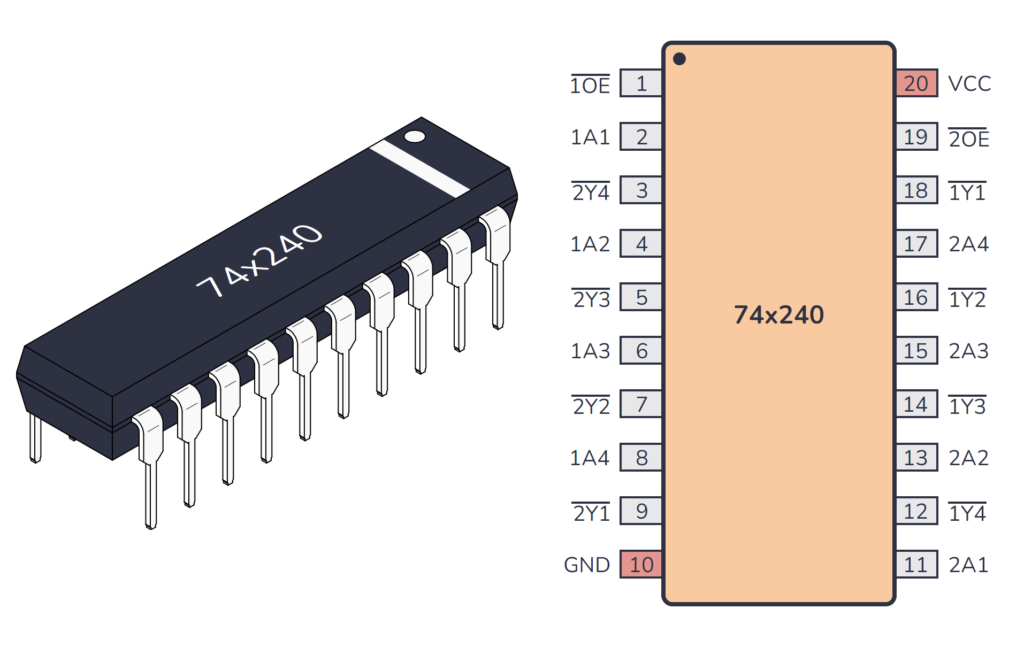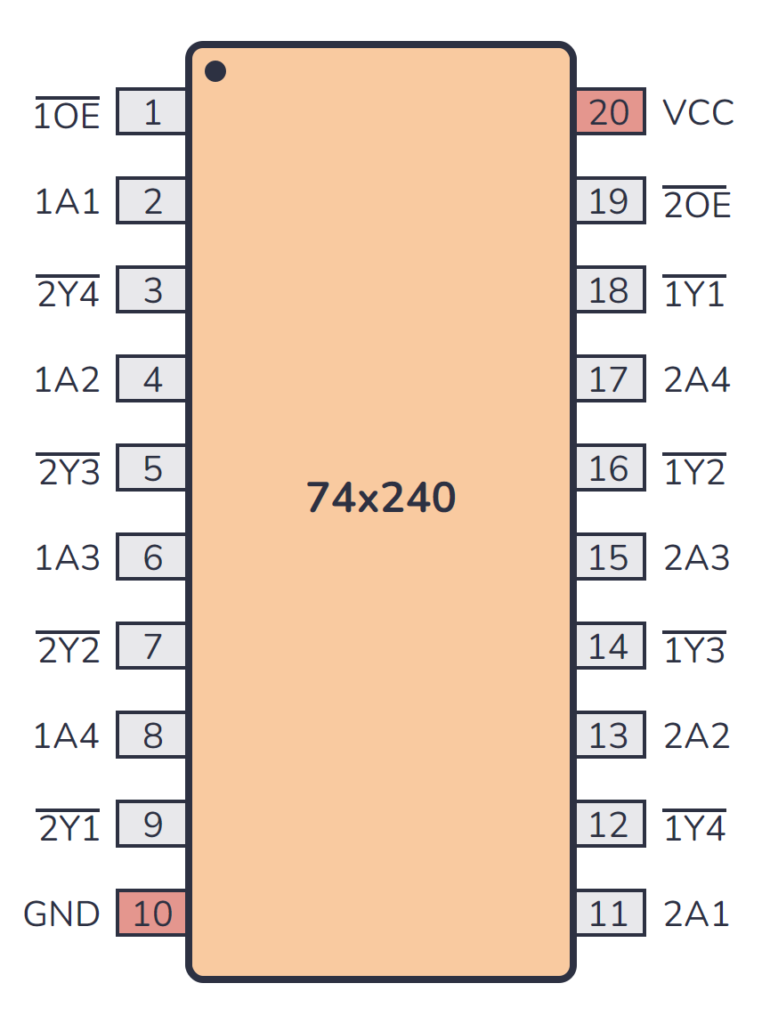The 74×240 (ex 74HC240) is a chip that contains eight inverting buffer/drivers with tri-state outputs. This configuration is particularly useful for driving data buses and providing temporary output isolation.
In this guide, you’ll learn the things you need to know about this chip in order to effectively use buffer/drivers in your own projects.

What does the 74HC240 / 74LS240 do?
The 74×240 is an octal buffer/line driver, meaning it has eight (octal) buffer gates. It is used to send signals from one part of a circuit to another without weakening them.
This chip has three-state outputs, so it can drive high (send a strong signal), drive low (send no signal), or be in a high-impedance state (like it’s disconnected). The high-impedance state lets multiple devices share the same output lines without interfering with each other.
The 74×240 has two sets of four buffer gates, and each set is controlled by an enable pin. When the enable pin is low, the buffers are active. The chip also inverts, or flips, the input signal. This means a high input becomes low, and a low input becomes high.
This makes the 74×240 convenient for controlling data flow in circuits. It is often used in computers, communication devices, and more!
How To Use This Chip
The 74HC240 comes in a 20-pin package. Most 7400 ICs support a VCC voltage of 5V. But one difference between the HC and LS version of the chip is that the 74HC240 supports 2V to 6V, while the 74LS240 only supports 5V.
The 74HC240 can supply up to 25 mA of current from an output pin. The 74LS240 can sink 24 mA and source 15 mA of current from an output pin.

Build Something Useful This Evening
This gadget lets you use any IR remote-control to control your lamp, garden lights, heater oven, garage door, or anything else.
(These values can differ between models, so check the datasheet of your model to verify.)
74×240 Pinout
The 74×240 has 20 pins and contains two 4-bit 3-state inverting buffer/line driver laid out as shown in the pinout diagram below:

| Pin Name | Pin # | Type | Description |
|---|---|---|---|
| 1OE | 1 | Input | Output Enable for the first set of four buffers (active low). |
| 1A1 | 2 | Input | First input to the first set of four buffers. |
| 1Y1 | 3 | Output | Inverted output from the first buffer. |
| 1A2 | 4 | Input | Second input to the first set of four buffers. |
| 1Y2 | 5 | Output | Inverted output from the second buffer. |
| 1A3 | 6 | Input | Third input to the first set of four buffers. |
| 1Y3 | 7 | Output | Inverted output from the third buffer. |
| 1A4 | 8 | Input | Fourth input to the first set of four buffers. |
| 1Y4 | 9 | Output | Inverted output from the fourth buffer. |
| GND | 10 | Power | Connect to ground (GND). |
| 2A1 | 11 | Input | First input to the second set of four buffers. |
| 2Y1 | 12 | Output | Inverted output from the fifth buffer. |
| 2A2 | 13 | Input | Second input to the second set of four buffers. |
| 2Y2 | 14 | Output | Inverted output from the sixth buffer. |
| 2A3 | 15 | Input | Third input to the second set of four buffers. |
| 2Y3 | 16 | Output | Inverted output from the seventh buffer. |
| 2A4 | 17 | Input | Fourth input to the second set of four buffers. |
| 2Y4 | 18 | Output | Inverted output from the eighth buffer. |
| 2OE | 19 | Input | Output Enable for the second set of four buffers (active low). |
| VCC | 20 | Power | Positive power supply. Connect to +5V power. |
Alternatives and Equivalents for 74HC240 / 74LS240
There are many versions of the 74×240 chip. They all have the same functionality, but with different specifications such as supported voltages and maximum current output.
Here’s a list of a few equivalents of this chip:
- 74HC240 (High-speed CMOS)
- 74HCT240 (High-speed CMOS, TTL compatible)
- 74LS240 (High-speed TTL)
- 74LVC240 (Low Voltage TTL)
- 74AC240 (Advanced CMOS)
- 74ALS240 (Advanced Low-Power Schottky TTL)
- 74F240 (Very High Speed)
- 74C240 (CMOS, similar to the 4000-series)
Some manufacturers also add a prefix, such as the SN74HC240 and SN74LS240 by Texas Instruments.
Can’t find the 74×240 anywhere? Then try one of the following IC alternatives:
- 74×241 – Octal buffer/line driver with 3-state outputs.
- 74×244 – Octal buffer/line driver with 3-state outputs.
- 74×245 – Octal bus transceiver with 3-state outputs.
- 74×541 – Octal buffer/line driver with 3-state outputs.
- 74×640 – Octal bus transceiver with 3-state outputs.
- CD4503 – Hex non-inverting buffer with 3-state outputs.
If you can’t find the 74×240 IC in your local electronics store, don’t worry, you’ll most likely find it in one of the stores listed on this page of online stores where you’ll find components and tools for all your electronics projects.
Datasheet for the 74LS240 and 74HC240 chips
Download the PDF datasheet for your version of the 74×240 here:
- SN74HC240 (Texas Instruments)
- SN74LS240 (Texas Instruments)
- 74HC240 (Futurlec)
- 74LS240 (Futurlec)
- 74HC240 (Nexperia)

10 Simple Steps to Learn Electronics
Electronics is easy when you know what to focus on and what to ignore. Learn what "the basics" really is and how to learn it fast.

